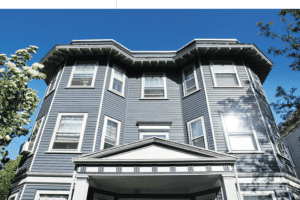
A small apartment building in Cambridge. Support for expanding multifamily housing by-right was widespread among candidates for Cambridge office in a 2023 questionnaire. iStock photo
Beneath a facade of inclusivity and progressivism lies an ugly truth: Cambridge is not open to everyone.
Hidden in the technical details of Cambridge’s zoning ordinance is a system designed to control who lives where, by limiting the type of housing that can be built – particularly multifamily apartments, such as the triple-decker. This system is referred to as “exclusionary zoning”, and its roots are in segregation.
We see its manifestation today in a housing crisis that prices more people out every year. At A Better Cambridge, a pro-housing advocacy group dedicated to making Cambridge a more inclusive, affordable city, we believe the time to change this system is now.
Ending exclusionary zoning is an equity issue, a family issue and, of course, a housing affordability issue.
Roots in Redlining
Cambridge’s zoning was designed to segregate. In the late 1920s and 1930s, Federal redlining maps marked West Cambridge as “still desirable” while describing the eastern half of the city as “definitely declining” or “hazardous” due to its Black and immigrant populations. After court decisions and federal laws invalidated explicit racial discrimination, “we went from banning certain kinds of people from our communities to banning the kinds of housing in which those people lived – namely, apartment buildings designed for multiple families – achieving the same ends,” as author Matthew Desmond writes in his book, “Poverty, by America.”
Shut out of decades of gains in real estate values, by 2015 the median U.S.-born Black household in the Boston metropolitan area held just $8 in net assets, compared to $247,500 for white households. Many Boston municipalities went so far as to explicitly use age restrictions to avoid higher school costs from apartment-dwelling families; others discouraged housing for children more indirectly through the special permitting process.
This exclusionary legacy persists in Cambridge today: West Cambridge remains our most exclusively zoned area, with large swaths dedicated solely to single family homes. Among all neighborhoods, it has the highest per capita income ($104,000) and the lowest percentage of Black residents (2.7 percent). This segregation by class and race may not reflect the attitudes of most Cambridge residents today, but it happened by design.
The past century of housing restrictions were devastatingly effective. From 1980 to 2020 (pre-pandemic), Cambridge added about 45,000 net new jobs but built only around 12,600 homes. Without legal and political barriers, an increase in demand would spur an increase in supply, but with exclusionary zoning keeping a lid on new housing construction, prices simply soared.
The median one-bedroom apartment rented for $2,700 in 2023 and the median condo sold for $870,000 in 2023, prices among the highest in the nation. More and more of our neighbors are being priced out of Cambridge, with more than 22,500 households on Cambridge Housing Authority waitlists for subsidized housing. Families with children bear an especially high burden, with many making the tough decision to move.

Dan Phillips
A Historical Opportunity to Change
We can change this. The Cambridge City Council has the power to rewrite our city’s zoning code, and Cambridge would not be alone. Cities such as Spokane, Arlington, Portland and Minneapolis are bidding goodbye to single family zoning.
Done well, zoning reform has the potential to unlock thousands of new homes. We should aim to promote new multifamily building construction in all residential districts, with the neighborhoods that are currently most exclusive seeing the most change. With the right height and density standards in place, we don’t need to forego open and green space. On the 2023 ABC candidate questionnaire, nearly every candidate said they would support allowing – at minimum – 4-story multifamily housing as of right city-wide, but the benefits of density would be greater with more height. Zoning rules should incentivize new unit production, including larger units for families, rather than downward conversions from existing multifamily housing to spacious, expensive homes affordable to only the wealthiest households.
What the City Council should not settle for is a surface-level fix that narrowly “allows” multifamily housing or “legalizes what’s there” without deeper changes to the dimensional standards that prevent new multifamily construction. Unknown to most Cambridge residents, most of the buildings they live in are out of compliance with current zoning, as much of Cambridge’s housing stock predates the city’s restrictive zoning rules. Ending exclusionary zoning means building new homes for more people.
Change will be slow. It takes time to build housing, and construction costs are at an all-time high. All the more reason to act now. Cambridge has a historical opportunity to confront its exclusionary housing legacy and tackle the housing crisis. Let’s seize it.
Dan Phillips is co-chair of A Better Cambridge, a volunteer advocacy group that is a member of Abundant Housing Massachusetts.





